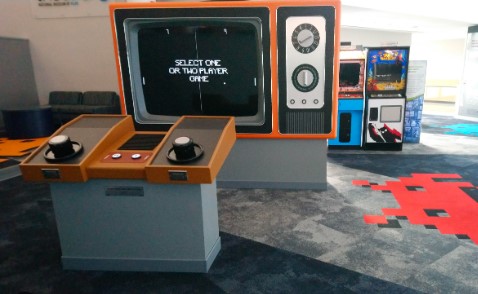Reviving the Arcade: HTML5 Styles Bringing Retro Games to Life
The resurgent interest in classic arcade games juxtaposed with modern advancements in web technology invites an exploration into how HTML5 is rejuvenating retro gaming experiences. This convergence defines a nostalgic revival, where beloved games of yesteryears are being reimagined for contemporary audiences. The following examination elucidates the technological frameworks supporting this renaissance, the cultural implications of retro gaming, and the potential future of the arcade experience.
Technological Frameworks and Innovations
HTML5 stands as the cornerstone of modern web development, providing a robust platform for game developers to create immersive and engaging experiences without sacrificing accessibility. One of its most significant advantages is the incorporation of multimedia capabilities, which allow developers to integrate audio, video, and animation seamlessly.
Game developers harness the power of Canvas, a fundamental HTML5 feature that facilitates dynamic graphics rendering. Through the Canvas API, developers can draw complex shapes, images, and animations, emulating the pixelated aesthetics of classic arcade titles. This feature is instrumental in replicating the visual fidelity of retro games while remaining scalable across a plethora of devices, thereby preserving the integrity of the gaming experience whether on a desktop or mobile screen.
Moreover, the Web Audio API significantly enhances auditory elements, enabling intricate sound design that harkens back to the blips and beeps of classic arcade machines. This API allows sound effects and background music to be spatialized, employing techniques that amplify user engagement through immersive audio landscapes.
Furthermore, the rise of JavaScript frameworks tailored for game development, such as Phaser and PixiJS, propels the efficiency of developing and deploying retro-style games. These frameworks simplify the intricacies of game logic and physics, empowering developers to focus on creativity rather than coding minutiae.
Cultural Relevance of Retro Gaming
The allure of retro games encompasses a multifaceted nostalgia that transcends mere entertainment. For many, these games evoke cherished memories of youth spent in dimly lit arcade halls, surrounded by the sounds of excited players and the hum of neon lights. This longing for the past is a psychological phenomenon often referred to as “nostalgia culture,” which frequently resurfaces in various forms, including fashion, music, and technology.
Modern adaptations of classic games encapsulate the simplicity and charm that characterized early video gaming. Titles like “Pac-Man,” “Tetris,” and “Space Invaders” have found new life through HTML5, not merely as updates but as cultural artifacts that captivate a new generation of gamers. Each pixel and sound encapsulated in these adaptations serves as a reminder of the communal experiences shared within arcades, fostering connections among players that extend far beyond the screen.
Moreover, the economic landscape surrounding retro games has transformed dramatically. The proliferation of free-to-play arcade games hosted on various platforms fuels a burgeoning community of players and developers, fostering an environment where developers can experiment with creative nuances while simultaneously forming nostalgic bonds with their audiences. These platforms have redefined accessibility, allowing players to experience classic games without financial barriers, thus democratizing the retro gaming landscape.
The Intersection of Education and Retro Gaming
One of the most intriguing domains where HTML5 retro games are gaining traction is within educational settings. Developers have begun to harness the engaging nature of these games as pedagogical tools, aiming to convey complex concepts through interactive gameplay. The simplicity of mechanics in classics like “Bubble Bobble” or “Donkey Kong” serves as an excellent framework for teaching critical skills, such as problem-solving, strategy, and teamwork.
Game-based learning has garnered momentum, with educators recognizing the potential of these retro-style games to captivate students’ attention. Integrating HTML5 games into curricula encourages cognitive development, particularly in areas related to mathematics and logical reasoning. The framework’s adaptability allows educators to customize learning experiences relevant to their students’ needs, infusing enjoyment into the educational process.
Furthermore, coding boot camps and workshops increasingly utilize retro game development as a teaching tool, providing learners with opportunities to grasp programming fundamentals while simultaneously creating a piece of entertainment that reflects their creativity. By employing projects based on familiar arcade titles, educators can bridge the gap between theoretical concepts and practical application, making learning more dynamic and engaging.
Challenges and Considerations
Additionally, the preservation of authenticity is another concern. As retro games undergo modernization, there exists a risk of diluting their original essence. The pixels, sound design, and gameplay mechanics that defined these classics should be honored, ensuring that new iterations resonate with both longtime fans and newcomers. Finding this equilibrium is paramount, as it directly influences how future generations perceive these iconic titles.
The Future of the Arcade Experience
Looking forward, the future of arcade gaming in the context of HTML5 holds immense potential for innovation and exploration. The continuous evolution of web technologies suggests that immersive gaming experiences will only improve. Advancements in browser capabilities and internet speeds will facilitate increasingly complex and visually stunning games, allowing developers to push creative boundaries.
The integration of augmented and virtual reality (AR/VR) technologies may revolutionize how players interact with retro games. Envisioning a setting where players physically engage with nostalgic titles, perhaps even in virtual arcades populated by familiar characters and settings, presents fascinating possibilities for the future. These developments promise to deepen player engagement, marrying nostalgia with innovation in unprecedented ways.
In summary, the revival of arcade gaming through HTML5 not only reconnects players with their past but also introduces new audiences to the charm and simplicity of retro games. As technology continues to advance, the nostalgic allure of these classic titles persists, fueled by innovations that promise to enrich the experiences of current and future gamers alike. The confluence of technology, culture, education, and creativity heralds a vibrant era for retro gaming, ensuring that the arcade experience remains alive and well for years to come.



